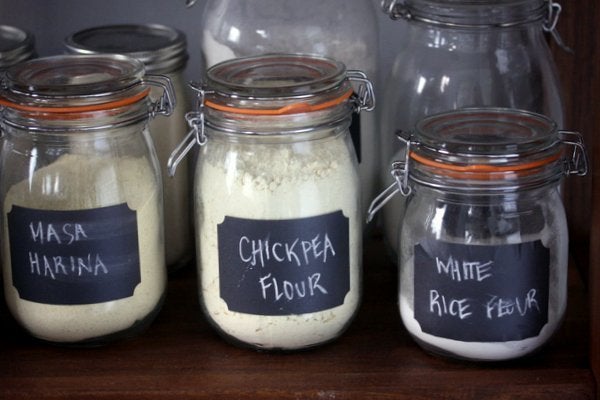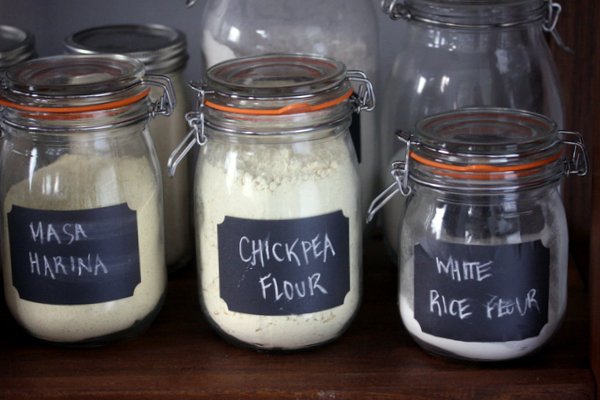
When I was first diagnosed with my gluten allergy two years ago, I felt totally lost. My cabinets were jam packed with pasta and barley and flour. I was used to cooking naturally gluten-free -- meaning, I used fresh vegetables and grains (like quinoa) that didn't involve any tinkering. But the world of GF flours was a mystery to me.
Luckily, my mom has been experimenting with different flours for years. I've adopted some of her go-tos and wanted to share them below with you.
My worst fear is coming across a recipe that calls for seven different flours and starches, and xanthum gum. Since I live in New York City, I know that jars take up valuable real estate in the kitchen (pictured above are a few of mine with Martha Stewart Avery chalkboard labels!). Here are my favorite five gluten-free flours that I like to keep around the house and some recipe ideas to keep those canisters from getting dusty.
--Phoebe Lapine of Feed Me Phoebe
1. White Rice flour. This is what I use as my all-purpose gluten-free flour. I like it for dredging, thickening -- really anytime I need a tablespoon or so of regular flour (like in this chocolate cake recipe). It has a very mild taste and seems to play nicely with most foods. For the record, rice pasta is also not too shabby! Like most GF flours, rice flour has a different density than regular AP flour. If you want to use it interchangeably in a recipe, you should weigh it instead of measuring it cup for cup. I use rice flour as the base for my cornbread -- no xanthum gum required! -- and also for my fish and chip batter. These cornmeal cakes are also great. If cornmeal was a flour, I would put it in a tie for number one!
2. Millet flour. I have my mom to thank for introducing me to millet flour. It's certainly not the most common, but I've found nothing better for getting a nice crispy coating on pan-fried meat or fish. My mom uses it all the time during the summer when she cooks up little vineyard sole with tartar sauce (try it with fried calamari too). It also works great with any dish that calls for dredging like this chicken fricassee.
3. Chickpea flour. I recently became obsessed with Socca. It's a simple Italian chickpea flour based pancake that seriously satisfies those bready cravings. I make it all the time as a side dish, where the bread basket would ordinarily be. Baked Falafel is another easy favorite and uses a couple tablespoons of the stuff.
4. Buckwheat flour. I admit, I don't have tons of uses for buckwheat flour. But these savory buckwheat crepes are a breakfast go-to much in the way pancakes are for most people. You can serve anything you want inside of them, which makes them a great vehicle for leftovers. Here's a great cake recipe from Smitten Kitchen and muffins from Yummly.
5. Masa Harina. Mexican is my favorite gluten-free cuisine, and masa harina is the base of a lot of dishes. Warning: masa is different from corn flour and should not be used interchangeably. You can make homemade corn tortillas. Or, my favorite sandwich bread alternative, arepas. It also is a nice thickener for chili if you don't want to soupy consistency.
For more gluten-free ideas, visit Feed Me Phoebe
